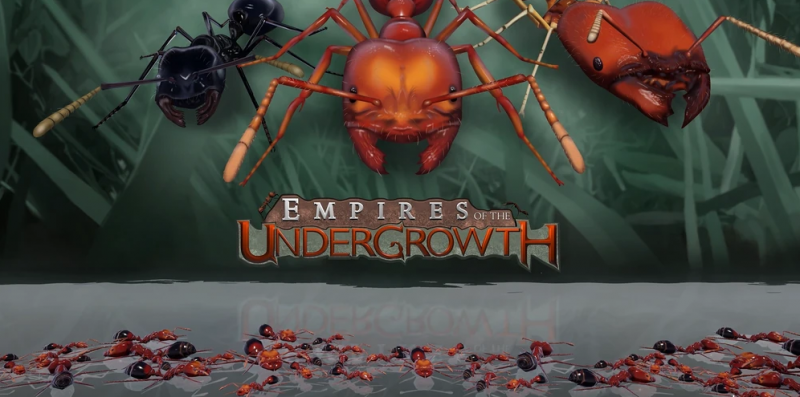Existing User Log In
New User Registration
Register for a free account to gain full access to the VGChartz Network and join our thriving community.





America - Front


America - Back

16th Jul 2024 | 15,186 views
Game: Empires of the Undergrowth
Platform: PC
Year: 2024
Developer: Slug Disco
Genre: RTS
The RTS genre is a very flexible one, which allows developers to explore many different settings and ideas. However, most of the settings presented often center around familiar scenarios, either historical, fantasy or sci-fi. And while there have been quite a lot of experimentation in terms of mechanics over the years, it is very rare for an RTS to fully move away from this. One of the more unorthodox ideas that has been more discussed has been an ant/termite based game. It seems like a relatively easy and alluring proposition. The behavior and lifestyle of eusocial insects, when analyzed up close, does follow behaviors and situations that can easily be translated into RTS mechanics. However, there have nor been that many major attempts of actually turning this idea into a full on videogame. Examples like the more simulator approach of the 90’s classic SimAnt or the more true RTS 2001’s Empire of the Ants are some of the few examples that come to mind, but outside of these, it is strange that such an idea wasn’t developed fully into a game. Thus, when I heard that there was a proper ant-based RTS called Empires of the Undergrowth being developed, I was quite hopeful that it would turn out well. However, as it was an early access game, I decided to not play it until its development was done. And with the developers taking the game out of early access this year, I finally decided to try it and see if it really met with all my expectations.
Empires of the Undergrowth is an RTS developed by Slug Disco, first released as an early access in 2017 and fully released in 2024. The game puts you in command of a colony of ants, and it’s your duty to lead the colony to make it survive and thrive, both underground and on the surface.
Before I start, a bit of disclosure. I supported this game when it was in early access, something that I do not usually do (I have heard enough horror stories of early access to be weary of it in general), but the idea of an ant simulator was something really appealing to me, and thus I actually got it during its early access period. However, I refrained from playing it until it was fully released, so I do not know how it compares to previous builds. Also, as the developers have announce that they are still working to add features to the game, this review will only talk about the current state of the game by the time of writing this.
The game’s basis is very simple. You play as a colony of ants trying to survive and grow in the while, and your objectives are to expand, to defeat your opposition and to protect the queen. You start with a couple of units underground, with which you have to dig your colony further, find whatever crumbs of food you can underground, and once you have managed to build your ants somewhat, you can begin exploring the overworld. Each game has two levels: the underground, in which each player’s base of operations is located, and the surface, where most of the resources and dangers are located. Your ants need to first expand their underground base, preparing the food storage and the spawning point of ants strong enough to explore the outside world. Once that is done, you move to explore the overworld, find food and bring it back to the colony to build up strength and numbers. And I mean numbers, as ants will need the strength of numbers to face off the many dangers present. Ants are not particularly strong, but in numbers, they can take on any of the many critters moving around. Once that is done, you can focus on fighting other ant colonies to establish your own into the dominant force in the undergrowth.
The gameplay loop of this is very satisfying. It helps that the mechanics are deceptively simple, but the more you play the more you notice the need for strategy, planning and a lot of attention. First, the underground. Unlike the overlworld, it is divided in hexagonal spaces, which need to be dug and cleared out to allow the ants to build their colony, from the nurseries for the larvae to the food storages to other more specialist things. The bigger the colony, the more space you will need, and thus eventually will need to clear out areas of the underground occupied by predators, which if one is too careless, can actually end your game before it even starts. A thing that needs to be taken into account is the way the space is organized, as a hexagonal distribution often helps things like the upgrades when you get to that. Once on the outside, one will find a plethora of food available, but the threats will be bigger as well. The ants will need to move around, choosing when to attack a big creature or when to avoid it, while also keeping them from entering your colony.
Your ants cannot be moved individually. instead, you have to group them into 5 different sets, which then move to wherever the player indicates. They then act automatically depending on the behavior options set for them, prioritizing fighting, foraging or both. However, this shows one of the big limitations of the game, as the ants act like wild animals. They will always behave with some autonomy regardless of the player’s orders. They will not stay still once they reach a point, instead roam a small area around the indicated spot, which can cause some other critters to detect them when you don’t want to. When they are in a fight, many of them will stay and fight even though you want them to flee. You can indicate the behavior preferences in the menu, but it does not always help. This means you need to be very careful of your surroundings, as well as plan your travels outside of the colony, but fortunately, there is no fog of war by default, so you can see the threats coming (you can activate it in the custom games if you want, though). Another problem with the movement is their pathfinding. If you want to avoid dangers by taking a longer route, you cannot use multiple markers to create a path to your target, the game only allows you to mark the spot where you want to go to, which is quite annoying. The game automatically chooses the shortest path between your nest (and your ants’ current location) and the point marked, no matter the obstacles in the way. This can make some levels in the campaign and in the skirmish maps quite annoying, as you are forced either to fight or to sacrifice a great deal of ants to get to your objective. This limits the gameplay somewhat, but also helps the game differentiate itself from many other RTS, as well as help with the immersion in the world.
In terms of unit variety, the game offers you a total of nine (eight regular species plus the campaign’s special ants) types of insects, which serves as the factions of the game. The black ants, the wood ants, the leafcutter ants, the fire ants, the big-headed ants, the little black ants, the Matabele ants and the termites, plus the “gene-thief” ants, a species from the campaign that has all the special units of the other factions (take a guess which faction is the strongest). Each of them has special units, with some having access to range attacks, some to giant ants, some to very small but very spammable ants, some to medic ants… In general, all species are very strong and capable, and all of them are fun to play, though I feel like the plant eaters (especially the leafcutter ants) suffer from balance issues. Both termites and leafcutters are specialists, only gathering one kind of resource (wood for termites, leaves for the leafcutters), while in comparison, the other ants can eat from a wide variety of foods: other insects, seeds, aphid resin, dead fish, rotting pinecones… which are much more available and widespread. Not only makes these ants find food much easier, and thus grow quicker, but also the termites and leafcutters have further problems. In the termite’s case, when an ant kills a termite, it can then eat it and recover resources lost, while a termite cannot do the same, putting the termite at a disadvantage. In general, ants cannot eat other ants, I imagine for balance reasons, though if that is the case I do not see why this was allowed to affect the termites. If a termite fails an assault into an enemy colony, the ants can eat the fallen termites and recoup a great deal of their losses, whereas this cannot be done for the termites, putting them at a considerable disadvantage on the defense. And as for the leafcutters, they have to balance very carefully the space within their colonies, as the detritus caused by fungi can make the ants sick, giving them a penalty in movement and in food storage. This contrast quite a lot with my favorite kind of ant, the matabele ants. Not only the matabele can heal their own units back from the dead (albeit with a slight penalty), not only they start with three big soldier units from the beginning, but they also always appear near AI termites spawn points, allowing it to have easy access to food. All this is compensated by being slightly more expensive. I remember playing a skirmish game, me playing the termites and the AI playing the matabele ants. The only access into each other’s nests was blocked by a toad, one of those massive bosses that would take forever to bring down. Neither one of us seemed interested in losing units first, as the moment that would happen the other would jump at the other. And while I exhausted all the wood in my area, the matabele player kept feeding from the termite spawn point, plus all of the other critters that kept appearing in the overworld. In the end, I managed to cheese it by tricking the AI into attacking the toad, but if this had been against a human opponent, this would not have been winnable. This kind of balance issue will need to be addressed at some point, the plant-eaters need a bit of a buff.
The strategy for all of them, however, is simple enough: get as many ants as possible and take over as many food sources as possible. The best way to do it is a single massive swarm of ants, as many as possible, not only taking over the food required and hunting down anything that stands in the way, but also keeping the other colonies from contesting it. Once you have enough ants, you have to go into the enemy’s nest and take down the queen. When you enter into an enemy colony, your ants will automatically go after the queen, generating massive battles within the tunnels of the colony.
Other than the playable units, there are tons of other critters moving around the world, both above and under the surface. From roly-polies that can do nothing but get eaten to massive scorpions that can tank dozens and dozens of ants attacking it, there is a great variety of creatures moving around the map, which serve both as threats to be mindful of and as targets to hunt and feed upon. Some creatures to be avoided at all costs at the beginning of the game are easy prey to a more developed colony, and seeing the giant mantises falling down after all the problems they can give you at the start of the game is quite satisfying.
The presentation of the game is stellar. Maps are highly detailed, with a lot of plant life and small critters running around, it does give you a vivarium vibe, and helps to get immersed in the game. Foliage can be somewhat obtrusive, though, since it can hide certain units or resources under the leaves, and you can only see what you is below if move the cursor into it. I imagine this could have been resolved by marking the outlines of the elements below the leaves with a different color and making this outline visible even when hidden by foliage.
In terms of game modes, the main attraction of Empires of the Undergrowth is the campaign. In the campaign, you play as the “gene-thief” ants, a colony of genetically modified ants being experimented upon in a lab. However, while the bulk of the campaign is the “gene-thief” ants, you can also level up your ants by playing secondary missions, allowing your ants to increase in population and gene-points, giving them extra-bonuses of sorts. These secondary missions play as single documentary-style scenarios with common ants, playable in multiple difficulties and with different degrees of challenge to obtain more or less bonuses. These levels are great, and I am still confused why the campaign did not completely revolve around them. I was expecting something akin to a campaign for each species with 3-5 levels for each, having a continuous and developing story, again, somewhat presented like a nature documentary. However, I am happy the “gene-thief” campaign also exists. Because it quickly becomes bonkers. Without spoiling too much, it is clear the developers had a lot of fun with the “gene-thief” campaigns (and it seems they are quite fellow fans of games such as Impossible Creatures). The campaign goes from “scientific experiments playing around with ants” to “what is even going on anymore??” and I admit quite enjoying it, even if it is in a b-movie kind of way. There is a bit of an annoying part, though, and that is that you cannot save the game during a mission. I imagine this is to avoid resource grinding by saving right near the end before you win, loading over and over and reap the rewards, but not being able to save the game is always an annoying thing, especially when you have to leave for whatever reason.
The skirmish games are quite good as well. While lack of map variety hurts this somewhat, with only seven maps currently available, there is a ton of customization available. Both the victory conditions, amount and behavior of the critters, the landmarks present, amount of food, difficulty over time… It is actually quite impressive the customization level, though the fact maps are limited to 4 players maximum per game is somewhat disappointing. However, there is one big glaring absence in the skirmish options, and that is a random option for choosing. Considering how basic a “random” button is, I am somewhat shocked this was overlooked. Seriously, I imagine it would not take that much time and effort adding an option like that, and it would spice things up quite a lot. And again, no save option. It has an autosave option, and an option to save when exiting, though, so at least that is that, but if the mechanic is there to that extent, why not allow regular saves?
Outside of skirmishes and the main campaign, the game also offers a couple of other features. First, a couple of challenge and extra levels designed to test the player’s knowledge and skill. They are fun, though not nearly as engaging as the previous two modes. Some of these levels are seasonal ones, which, while thematic, are also annoying, since you need to wait until certain dates to access them (that or change your computer’s date, but why make them season-locked in the first place?). It also has a battle arena mode, in which you can pity the game’s critters against each other, but if feels like an afterthought, and other than seeing the critters’ points and seeing which one is stronger, it has little to offer.
Two features lack due to their absence. First one is multiplayer. Now, I understand this is a small team and multiplayer requires a lot of effort, time and resources, not to mention the online infrastructure necessary to sustain games. However, if that is the case, why not just limiting it to peer-to-peer games, leaving the players to carry the burden of the servers? Or even allowing a LAN system to then use LAN emulators? It is a shame that a game with such fun gameplay does not have a multiplayer option, considering the gameplay is ripe for it. The second feature is a map editor of sorts. As the maps available are limited to the skirmish ones and the challenge maps, it would have been nice to see a map editor, both to create one’s challenges and for general skirmish maps. Outside of these two, an encyclopedia talking about the species and environments present in the game would be nice, kind of like the brief historic summaries historical games like Age of Empires II had. From what I have seen, the developers and the community have created a Fanon wiki for it, but it is just not the same.
Overall, this has been one of the most rewarding games I have played this year. Empires of the Undergrowth manages to offer an engaging gameplay loop around a very fun and unique idea, and it is clear the developers have put a lot of thought into it. The few lacking things in the game do not take away from the fun factor, and I am really happy this game not only successfully released, but the end product is as good as it is.
Score: 8/10